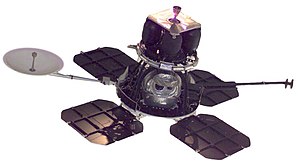cosmos.wikisort.org - Spacecraft
The 1966 Lunar Orbiter 1 robotic spacecraft mission, part of NASA's Lunar Orbiter program, was the first American spacecraft to orbit the Moon. It was designed primarily to photograph smooth areas of the lunar surface for selection and verification of safe landing sites for the Surveyor and Apollo missions. It was also equipped to collect selenodetic, radiation intensity, and micrometeoroid impact data.
This article needs additional citations for verification. (August 2013) |
 | |
| Mission type | Lunar orbiter |
|---|---|
| Operator | NASA |
| COSPAR ID | 1966-073A |
| SATCAT no. | 2394 |
| Mission duration | 80 days |
| Spacecraft properties | |
| Manufacturer | The Boeing Co. |
| Launch mass | 385.6 kg (850 lb) |
| Start of mission | |
| Launch date | August 10, 1966, 19:31 UTC[1] |
| Rocket | Atlas SLV-3 Agena-D |
| Launch site | Cape Canaveral LC-13 |
| End of mission | |
| Disposal | Deorbited |
| Decay date | October 29, 1966 "about 13:29 GMT"[2] |
| Orbital parameters | |
| Reference system | Selenocentric |
| Semi-major axis | 2,694 km (1,674 mi) |
| Eccentricity | 0.33 |
| Periselene altitude | 189.1 to 40.5 km (117.5 to 25.2 mi) |
| Aposelene altitude | 1,866.8 km (1,160.0 mi) |
| Inclination | 12 degrees |
| Period | 208.1 minutes |
| Lunar orbiter | |
| Orbital insertion | August 14, 1966 |
| Impact site | 6.35°N 160.72°E |
| Orbits | 577 |
Lunar Orbiter program | |
Mission controllers injected the spacecraft into a parking orbit around Earth on August 10, 1966, at 19:31 UTC. The trans-lunar injection burn occurred at 20:04 UTC. The spacecraft experienced a temporary failure of the Canopus star tracker (probably due to stray sunlight) and overheating during its cruise to the Moon. The star tracker problem was resolved by navigating using the Moon as a reference, and the overheating was abated by orienting the spacecraft 36 degrees off-Sun to lower the temperature.
Lunar Orbiter 1 was injected into an elliptical near-equatorial lunar orbit 92.1 hours after launch. The initial orbit was 189.1 by 1,866.8 kilometers (117.5 mi × 1,160.0 mi) and had a period of 3 hours 37 minutes and an inclination of 12.2 degrees. On August 21, perilune was dropped to 58 km (36 mi) and on August 25 to 40.5 km (25.2 mi). The spacecraft acquired photographic data from August 18 to 29, 1966, and readout occurred through September 14, 1966.

A total of 42 high-resolution and 187 medium-resolution frames were taken and transmitted to Earth covering more than 5 million square kilometers of the Moon's surface, accomplishing about 75% of the intended mission, although a number of the early high-resolution photos showed severe smearing. It also took the first two pictures of Earth from the Moon. Accurate data were acquired from all other experiments throughout the mission.
Orbit tracking showed a slight "pear-shape" of the Moon based on the gravity field, and no micrometeorite impacts were detected. The spacecraft was tracked until it impacted the lunar surface on command at 7 degrees north latitude, 161 degrees east longitude (selenographic coordinates) on the Moon's far side on October 29, 1966, on its 577th orbit. The early end of the nominal one-year mission resulted from a shortage of remaining attitude control gas and other deteriorating conditions and was planned to avoid transmission interference with Lunar Orbiter 2.
| Lunar Photographic Studies | Evaluation of Apollo and Surveyor landing sites |
|---|---|
| Meteoroid Detectors | Detection of micrometeoroids in the lunar environment |
| Caesium Iodide Dosimeters | Radiation environment en route to and near the Moon |
| Selenodesy | Gravitational field and physical properties of the Moon |
- The first image of Earth from the distance of the Moon, August 23, 1966. This probe took a second such image on August 25.
 Part of the photo to the left as reprocessed by LOIRP in 2008.
Part of the photo to the left as reprocessed by LOIRP in 2008.- Full reprocessed image from 2008.
See also
- Lunar Orbiter Image Recovery Project
- Exploration of the Moon
- Lunar Orbiter 2
- Lunar Orbiter 3
- Lunar Orbiter 4
- Lunar Orbiter 5
- List of artificial objects on the Moon
References
- Lunar Orbiter I: Extended Mission Spacecraft Subsystem Performance (PDF) (Report). NASA. The Boeing Company. September 1967. p. 37. NASA CR-870.
- Lunar Orbiter 1: America’s First Lunar Satellite | Drew Ex Machina
External links
- Destination Moon: A History of the Lunar Orbiter Program (1976) by the NASA History Office
- Lunar Orbiter Photo Gallery - Mission 1 by the Lunar and Planetary Institute
На других языках
[de] Lunar Orbiter 1
Lunar Orbiter 1 war die erste von fünf Mondsonden des Lunar-Orbiter-Programms der US-amerikanischen Weltraumorganisation NASA. Mit dem Lunar-Orbiter-Programm sollte der Mond in hoher Auflösung[Anm. 1] fotografisch erfasst und kartografiert werden, um so Landeplätze für die Raumsonden des Surveyor-Programms sowie für die bemannte Mondlandung zu finden.- [en] Lunar Orbiter 1
[ru] Лунар орбитер-1
«Лунар орбитер-1» (англ. Lunar Orbiter 1) — автоматический беспилотный космический аппарат NASA, разработанный в рамках программы «Лунар орбитер», был запущен 1966 году с целью картографирования поверхности Луны. Аппарат, успешно выполнивший поставленные цели, стал первым американским искусственным спутником Луны[3] (первым спутником 3 апреля 1966 года стала станция Луна-10[4]). Данные, полученные с первых трёх КА «Лунар орбитер», впоследствии использовались для определения мест безопасной посадки пилотируемых аппаратов «Аполлон»[5].Другой контент может иметь иную лицензию. Перед использованием материалов сайта WikiSort.org внимательно изучите правила лицензирования конкретных элементов наполнения сайта.
WikiSort.org - проект по пересортировке и дополнению контента Википедии



